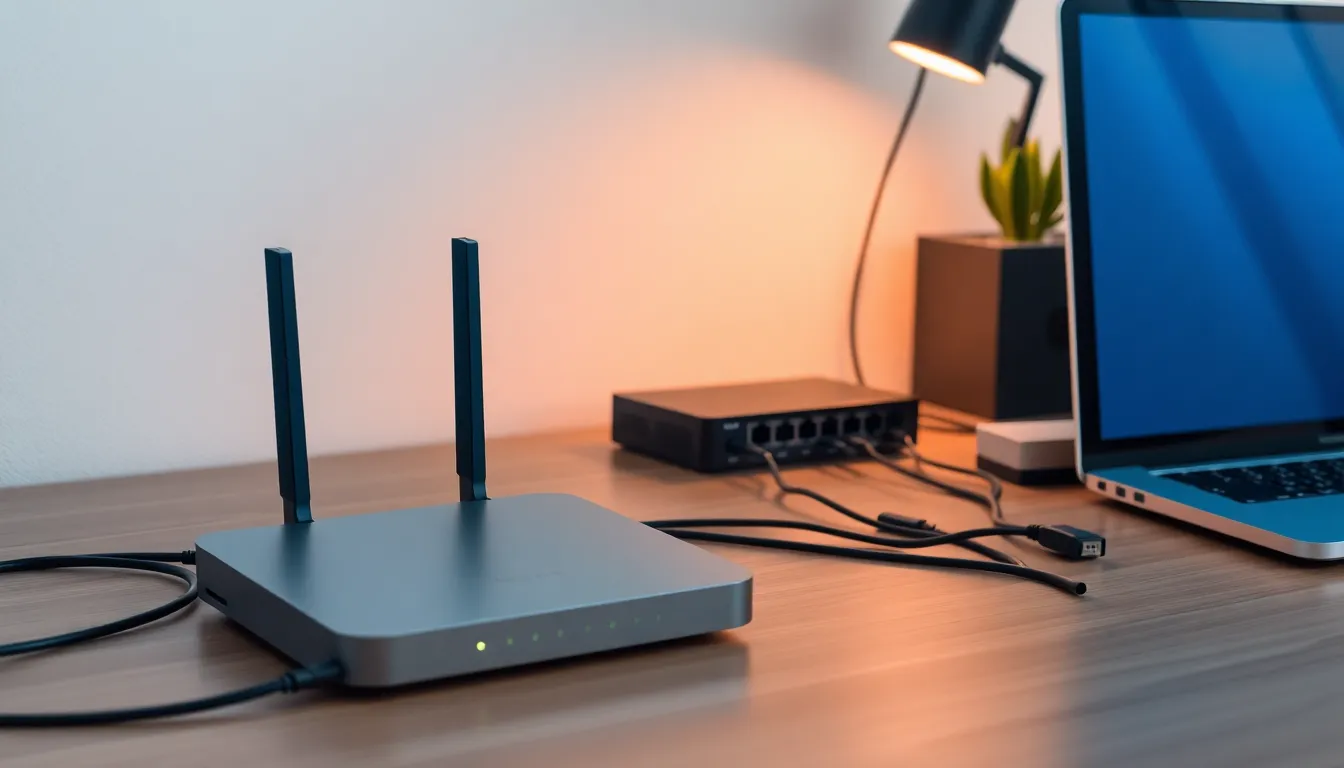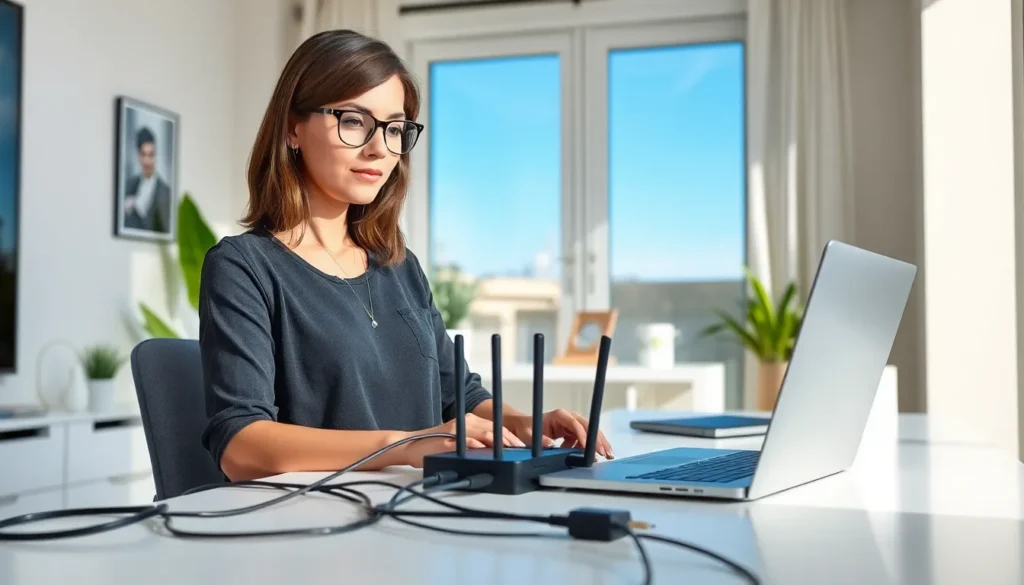Table of Contents
ToggleIn today’s digital age, a reliable home network isn’t just a luxury—it’s a necessity. Whether it’s streaming the latest binge-worthy series or video chatting with family, a solid connection keeps everyone happy. But let’s face it, setting up a home network can feel like trying to solve a Rubik’s Cube blindfolded.
Understanding Home Networking
Home networking connects devices within a domestic environment, allowing them to communicate with each other and access the Internet. This setup enhances convenience and efficiency for various online activities.
What Is Home Networking?
Home networking involves linking multiple devices such as computers, smartphones, smart TVs, and gaming consoles to a single network. Routers typically facilitate this connection by distributing Internet access via wired or wireless means. A well-structured home network ensures devices can share resources like printers or storage and access the Internet seamlessly.
Benefits of Home Networking
Multiple advantages arise from having a functional home network. First, it allows for shared Internet access among devices, reducing the need for individual connections. Second, home networking enables file sharing, making collaboration easier for family members or housemates. Third, it supports smart home devices, enhancing convenience and security. Fourth, reliable networks improve streaming quality for movies and games, minimizing disruptions during use. Lastly, users can manage their home network settings, adjusting security measures based on preferences and requirements.
Essential Components of a Home Network

Home networking consists of several essential components that ensure seamless connectivity. These elements include routers, switches, hubs, and network cables.
Routers
Routers serve as the central hub for home networks. They connect devices to the internet and manage traffic between them. Reliable routers support various standards, such as Wi-Fi 5 or Wi-Fi 6, enabling faster data transfer speeds. Many routers also come with built-in security features that help protect connected devices from unauthorized access. Users should consider the size of their home when selecting a router, as coverage can significantly impact performance.
Switches and Hubs
Switches and hubs expand network connectivity within a home. While hubs connect multiple devices, switches are more efficient, directing data only to the intended recipient. Switches can increase network performance by reducing collisions and improving response times. When adding extra devices, a switch often proves more beneficial than a hub due to its intelligent data handling. Selecting the right device depends on the specific needs of the home network.
Network Cables
Network cables are critical for wired connections between devices. Ethernet cables, particularly Cat5e and Cat6, provide fast data transmission rates. Reliable, high-quality cables reduce latency and enhance overall network performance. These cables are especially important for gaming consoles and home offices, where stable connections improve user experience. Ensuring correct cable lengths and types helps achieve optimal results in home networking setups.
Setting Up Your Home Network
Setting up a home network requires careful consideration of various factors to ensure optimal performance.
Choosing the Right Location for Your Router
Selecting the proper location for a router significantly impacts network quality. Central rooms within the home often provide the best coverage. Elevating the router off the floor enhances signal strength. Avoid placing the router in enclosed spaces, as obstructions weaken connectivity. Minimizing interference from appliances reduces signal disruption. A space free from walls and furniture improves overall wireless reach.
Connecting Devices to Your Network
Connecting devices to the home network ensures seamless online experiences. Begin by accessing the home network settings on each device. This process often involves selecting the network name and entering the Wi-Fi password. Devices like smartphones, tablets, and smart TVs can connect wirelessly. Ethernet connections provide stronger stability for gaming consoles and computers. Each device maintains access to shared resources like printers and files once connected. Always check firmware updates for devices to ensure compatibility.
Configuring Network Settings
Configuring network settings allows for improved security and performance. Access the router’s admin interface through a web browser using the router’s IP address. Change the default password to something more secure to prevent unauthorized access. Adjust settings like guest networks and parental controls to enhance usability. Setting up Quality of Service (QoS) prioritizes bandwidth for critical tasks, such as streaming or gaming. Regularly check network performance with speed tests. Monitor connected devices to detect any issues or unauthorized access.
Securing Your Home Network
Securing a home network is vital in protecting sensitive information and devices from unauthorized access. Cyber threats can compromise privacy and disrupt daily activities, making network security a priority.
Importance of Network Security
Network security safeguards data and devices connected to a home network. It prevents unauthorized users from accessing personal information and cybercriminals from exploiting vulnerabilities. Cyberattacks, including malware and phishing attacks, endanger all connected devices. A secure network enhances confidence in online transactions and communications. Establishing robust security measures not only protects devices but also ensures continuous access to vital online services, like video streaming and smart home applications.
Common Security Measures
Implementing strong security measures helps defend against potential threats. Change default usernames and passwords for all network devices, ensuring they are unique and complex. Enabling WPA3 encryption on Wi-Fi networks provides an advanced layer of security. Configuring firewalls, whether hardware or software-based, monitors incoming and outgoing traffic, blocking malicious activity. Regularly updating firmware on routers and connected devices fixes known vulnerabilities. Utilizing guest networks isolates visitors from sensitive personal devices, adding another layer of protection. Monitoring connected devices allows users to identify any unauthorized access quickly.
Troubleshooting Common Networking Issues
Common networking issues can frustrate users and disrupt online activities. Understanding these problems helps maintain a smooth home network experience.
Connection Problems
Connection problems frequently arise from various factors. Incorrect settings, physical obstacles, or outdated hardware often contribute to connectivity issues. Examine device settings first to ensure they align with the network configuration. Signal interference from appliances and walls may also disrupt connections, so repositioning the router might help. Checking the status of network cables is essential, especially with Ethernet connections. A damaged cable can lead to inconsistent connectivity. Restarting the router and devices can resolve temporary glitches as well.
Slow Network Speeds
Slow network speeds impact streaming and online gaming. Bandwidth congestion creates bottlenecks, especially when multiple devices use the network simultaneously. Identifying devices consuming excessive bandwidth is crucial; prioritizing essential tasks often improves overall performance. Weak signals may also cause slow speeds, so relocating the router to a central point enhances coverage. Running regular speed tests aids in monitoring performance. Updating the router’s firmware and enabling Quality of Service (QoS) settings ensures a more efficient distribution of bandwidth across devices.
Establishing a robust home network is crucial for navigating today’s digital landscape. By understanding the components and configurations necessary for optimal performance, users can enjoy seamless streaming, efficient file sharing, and secure online experiences.
Implementing strong security measures protects sensitive information from potential threats while regular monitoring ensures the network remains efficient. With the right setup and maintenance, anyone can transform their home network into a reliable hub for all online activities. Embracing these strategies not only enhances convenience but also fosters a safer and more enjoyable digital environment.







